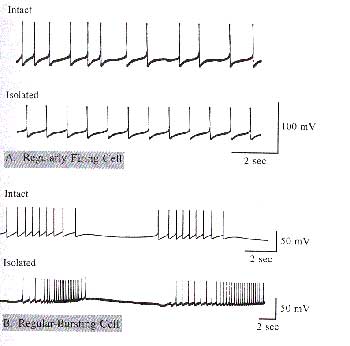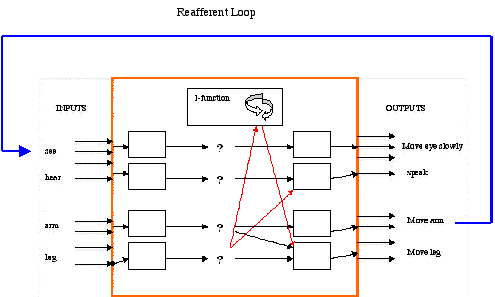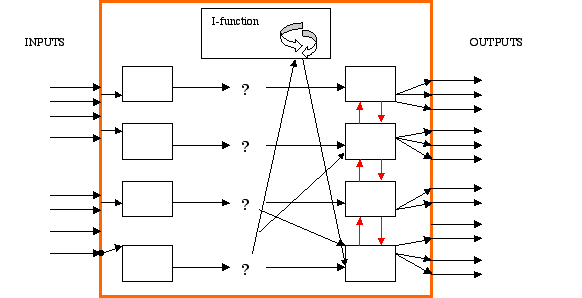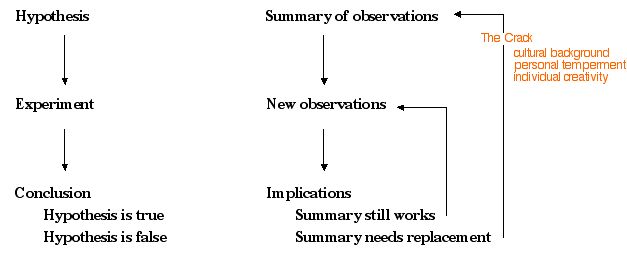From Bricks to Architecture: The Output Side of the Box
Review (the bricks):
neurons, action potentials, resting/receptor/generator potentials, synaptic potentials, inhibition, signals end and start in middle of box, thinking backwards about behavior
Yes, signals can start in the middle of the box, at all scales
Isolated Nervous System | Isolated Neuron |
|---|
 | 
|
| Isolated leech nervous system: activity in motor nerve (Brodfuehrer and Grobstein, see Variability in Brain Function and Behavior
| Isolated Aplysia neuron (Alving, B.O., J. Gen. Physiol. 51: 29-45, 1968; figure from Kandel, E.R., Cellular Basis of Behavior, W.H. Freeman, 1976, p 255) |
And inhibition important ("thinking backwards" about behavior)
Rather than causing students to do something: learn, stop talking, focus, whatever, we should try to identify and remove the element(s) that are preventing them from doing what we have asked.
Okay. I like that idea. If I'm understanding this appropriately, an important part of teaching is knowing as much as possible about each child ... it's one reason why I enjoy what I do and where I work ... Gayle
I liked the idea that we are actually inhibiting a lot of the actions that we don't want to occur.... it really explains my random twitch. But how does that work with education. How do we take away the things that may be inhibiting a child from learning ... what really differentiates adults from children? Why are we so different from them? What is this comment that we always make about "we know better," how so? Why do we know better? Is there something in us that is so different that makes us know that it is time to shut up or it's time to have a conversation? ... why did I not listen then and I would listen now? Inhibition? The ability to inhibit my desires or "natural actions" ... Minh
If it's true the nervous system is always being altered, are we aware of the changes when they occur? Is it possible some of our negative behaviors are related to some of those alterations? ... Patricia
it is a small number of the students who do not change their story. What is the difference between the students who revise and the students who don't? ... Susan
If the problem in my class is that students are not engaged in my lesson, then I should explore
why they are not engaged. Eliminate the reason before I can get the participation that I seek.
That requires knowing a lot about your students! How many teachers are willing to take that time?? ... Sherry
Consolidating: One way to see the brain work (takes time)
Moving on ...
- motor symphony
- central pattern generation
- corollary discharge
- coordination without a conductor
- backwards (right to left arrows) and expectation/models
- Purpose, expectation, creativity, exploration ... all without the I-function
Starting:

Learning from simplifying:

Extending the idea of internal signalling:

Adding back to get more:

And novelty generation/creativity/exploration ...
Key Points:
- Distributed control (rather than top-down hierarchy)
- Output as exploration (rather than response)
- Output associated with "expectation" or "model"
- Input as test of expectation/model (rather than "stimulus" or stamper)
- Exploring/learning can occur without I-function (sometimes, for some things, even better?)
- Education as exploration? as science?
>
Purposes (multiple) without I-function
Motor cortex
- "Voluntary" movement
- Inhibitor of movements one would otherwise make
- Creator of movements one would not otherwise make
- Part of "I-function"?
Unconscious provides foundation for "I-function"
Do you think these aspects of the nervous system are interesting/useful for educators to know about? Put your thoughts in the institute forum area.
| Institute Forum
| Brain and Behavior Institute 2006
| Summer Institutes
| Serendip Home |
Send us your comments at Serendip

© by Serendip 1994-
- Last Modified:
Wednesday, 02-May-2018 10:51:15 CDT










